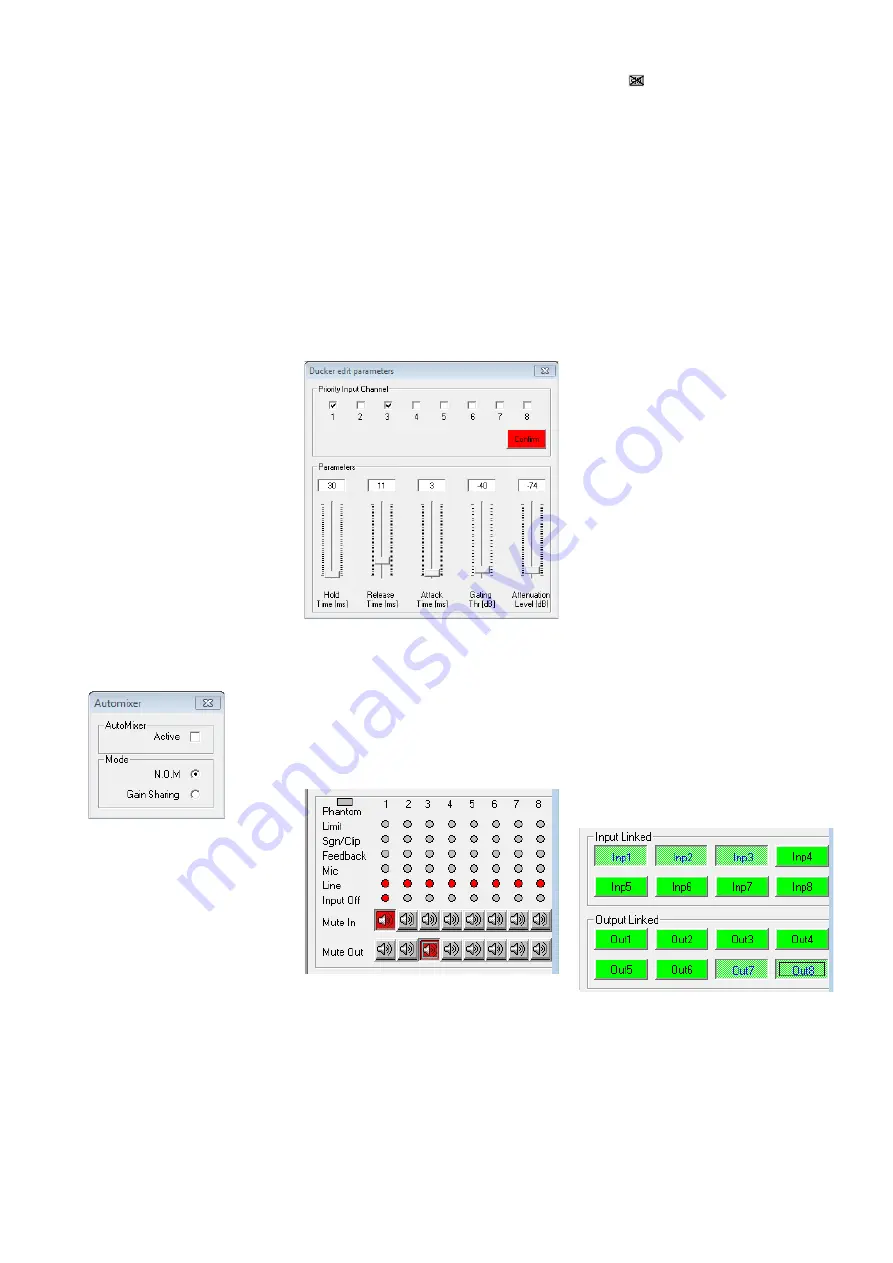
35
English
6.6 Automixer
Sometimes multiple microphones are re-
quired, but only one is used at a time, e . g .
in discussions . Due to the large number of
open microphone channels, there will be a
high level of background noise . This noise can
be quite annoying . The noise gate (
☞
chap-
ter 6 .4 .6) can be used to suppress low-level
noise from each microphone channel . For this,
however, the noise gate of each channel must
be accurately adjusted .
The function “Auto Mixer” is an addi-
tional option . Once you speak into one of
the microphones involved, this microphone
will be temporarily the master microphone .
The levels of all other microphones will be
attenuated .
To activate the automixer function, go to
the view “Overview” (fig . 18) and tick the
box “Active” under “Auto Mixer” . To set
the parameters, click “Edit parameter” . The
automixer window (fig . 29) is shown . There,
the operating mode of the automixer can be
selected:
With the operating mode “
N. O. M.
”, the at-
tenuation of the input channels will depend
on the number of open microphones . The
attenuation range is between 3 dB (two open
microphones) and 9 dB (eight open micro-
phones) .
With the operating mode “
Gain Sharing
”,
the total gain of all input channels will be kept
at a constant value . The highest gain will be
assigned to the channels with the highest
signal level; the gain of the other channels will
be reduced accordingly . The gain is calculated
in a way that makes sure that the volume
of the signal sum is such as if only a single
microphone channel is open .
Fig. 29 Automixer
6.7 Ducker
Another option to improve speech intelligi-
bility is to give specific channels priority over
other channels . Thus, background music can
be automatically suppressed while announce-
ments are being made .
To select the priority channels, go to the
view “Overview” (fig . 18) and tick the appro-
priate boxes “Priority Input Channel” under
“Ducker” . Then click “Confirm” to confirm
your selection .
To edit the parameters, click “Edit param-
eter” . The ducker window (fig . 30) will be
shown . There, the following parameters can
be set:
– Gating Thr: threshold value for the signal
level of the priority input channels; when
the level is exceeded, the other input sig-
nals will be attenuated
– Attack Time: attack time
– Hold Time: time for which the signals of
the non-priority input channels will remain
attenuated after the signals of the prior-
ity input channels have fallen below the
threshold value “Gating Thr”
– Release Time: time after which the atten-
uation of the signals of the non-priority
channels will be deactivated after the “Hold
Time” has elapsed
– Attenuation Level: attenuation level
When all settings have been made, click
in the upper right corner to exit the window .
Fig. 30 Ducker
6.8 Status display
Regardless of the view selected, the indica-
tors and controls on the right-hand side of
the window are always available . They show
the status and adjustments of the channels
(fig . 31) just like the status LEDs (4) on the
unit (
☞
chapter 5 .4) .
Fig. 31 Status display and muting
6.9 Muting
Use the buttons “Mute In” to mute the in-
puts, and use the buttons “Mute Out” to
mute the outputs (fig . 31) . To mute or unmute
a channel, click the appropriate button of the
respective channel . When a channel is muted,
the corresponding button appears in red and
the icon is shown in the view “Overview”
(fig . 18) for this channel .
6.10 Linking channels
If specific parameters for multiple outputs or
inputs are to be simultaneously adjusted to
the same values, the inputs or outputs may
be linked while the adjustments are being
made . Thus, the parameters changed for one
output will be adjusted accordingly for all
outputs linked . Likewise, any changes made
to one input will apply to all input channels
linked . Only the parameters changed while
the linkage was active are adopted by the
other channels . All individual adjustments of
the inputs or outputs are maintained .
To link input channels:
1) On the right-hand side of the window,
under “Input Linked” (fig . 32), click the
buttons of all the inputs whose parameters
are to be adjusted to the same value . The
buttons appear to be “pressed” and the
colour of their marking changes to blue .
These buttons are also available in the win-
dow “Inputs EQ” for input equalization
(fig . 24) .
2) To remove the link for an input, click the
button of this input again .
To link output channels:
1) On the right-hand side of the window,
under “Output Linked” (fig . 32), click the
buttons of all the outputs whose parame-
ters are to be adjusted to the same value .
If a view for a specific output (fig . 27) is
being displayed, click the button for this
output as well . The buttons appear to be
“pressed” and the colour of their marking
changes to blue .
The linkage will be maintained even when
another view is selected .
2) To remove the link for an output, click the
button of this output again .
Fig. 32 Linkage of inputs and outputs
Linking will have no effect on the following
functions: “Mute In“, “Mute Out”, and the
channel assignments “Output Routing” and
“Output mix level” or “Balanced” (input sig-
nal) .




















